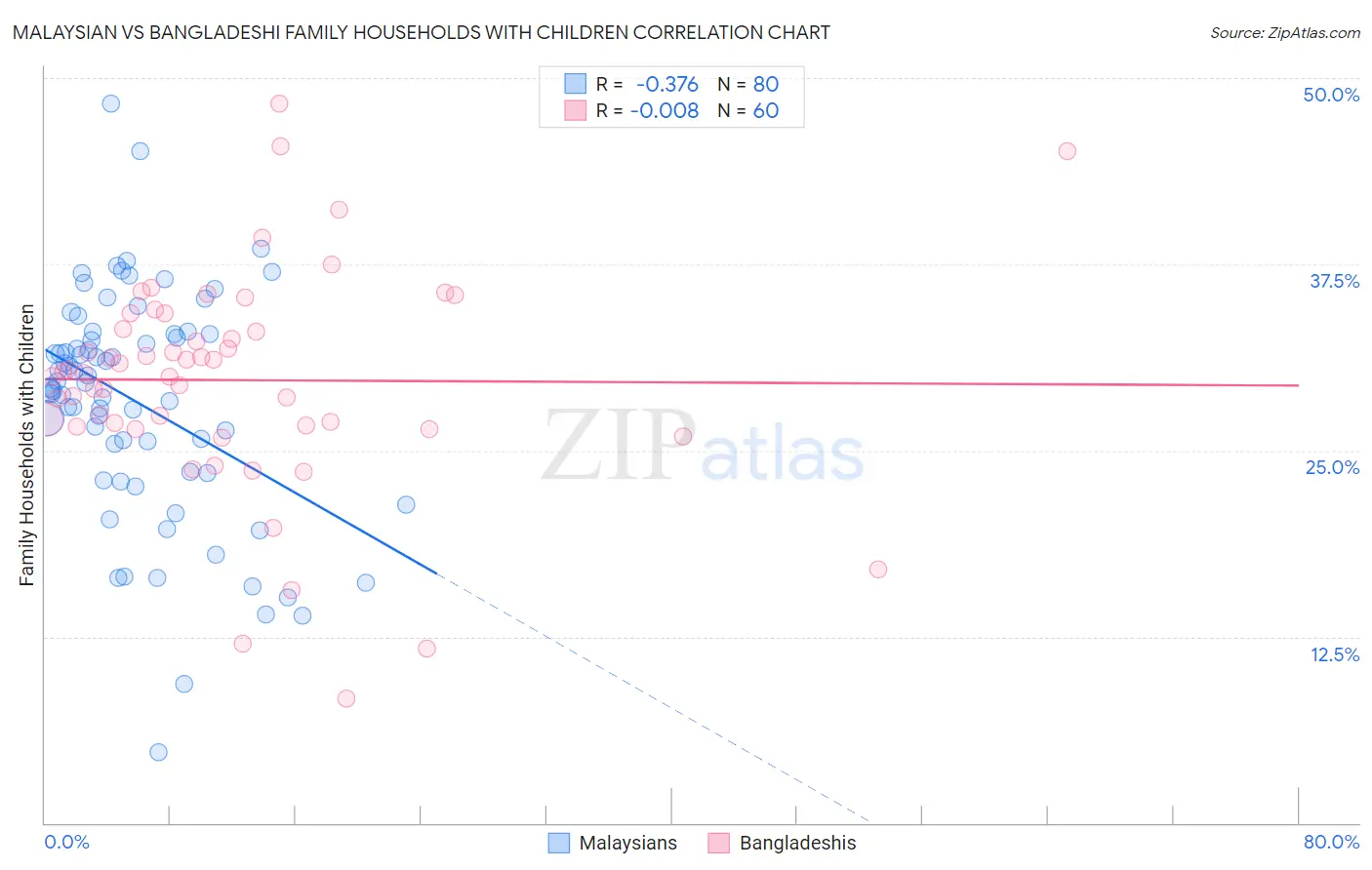Malaysian vs Bangladeshi Family Households with Children
COMPARE
Malaysian
Bangladeshi
Family Households with Children
Family Households with Children Comparison
Malaysians
Bangladeshis
29.8%
FAMILY HOUSEHOLDS WITH CHILDREN
100.0/ 100
METRIC RATING
22nd/ 347
METRIC RANK
30.1%
FAMILY HOUSEHOLDS WITH CHILDREN
100.0/ 100
METRIC RATING
14th/ 347
METRIC RANK
Malaysian vs Bangladeshi Family Households with Children Correlation Chart
The statistical analysis conducted on geographies consisting of 225,942,308 people shows a mild negative correlation between the proportion of Malaysians and percentage of family households with children in the United States with a correlation coefficient (R) of -0.376 and weighted average of 29.8%. Similarly, the statistical analysis conducted on geographies consisting of 141,328,833 people shows no correlation between the proportion of Bangladeshis and percentage of family households with children in the United States with a correlation coefficient (R) of -0.008 and weighted average of 30.1%, a difference of 0.92%.

Family Households with Children Correlation Summary
| Measurement | Malaysian | Bangladeshi |
| Minimum | 4.8% | 8.3% |
| Maximum | 48.3% | 48.3% |
| Range | 43.6% | 39.9% |
| Mean | 28.2% | 29.7% |
| Median | 29.4% | 30.2% |
| Interquartile 25% (IQ1) | 23.6% | 26.6% |
| Interquartile 75% (IQ3) | 32.8% | 33.7% |
| Interquartile Range (IQR) | 9.3% | 7.1% |
| Standard Deviation (Sample) | 7.7% | 7.4% |
| Standard Deviation (Population) | 7.7% | 7.4% |
Demographics Similar to Malaysians and Bangladeshis by Family Households with Children
In terms of family households with children, the demographic groups most similar to Malaysians are Immigrants from Laos (29.8%, a difference of 0.030%), Immigrants from El Salvador (29.8%, a difference of 0.080%), Alaska Native (29.9%, a difference of 0.11%), Salvadoran (29.9%, a difference of 0.14%), and Mexican American Indian (29.7%, a difference of 0.27%). Similarly, the demographic groups most similar to Bangladeshis are Immigrants from South Central Asia (30.0%, a difference of 0.17%), Immigrants from Afghanistan (30.0%, a difference of 0.20%), Afghan (30.2%, a difference of 0.28%), Immigrants from Pakistan (30.2%, a difference of 0.52%), and Hispanic or Latino (29.9%, a difference of 0.58%).
| Demographics | Rating | Rank | Family Households with Children |
| Yakama | 100.0 /100 | #8 | Exceptional 30.8% |
| Thais | 100.0 /100 | #9 | Exceptional 30.6% |
| Immigrants | Fiji | 100.0 /100 | #10 | Exceptional 30.5% |
| Nepalese | 100.0 /100 | #11 | Exceptional 30.5% |
| Immigrants | Pakistan | 100.0 /100 | #12 | Exceptional 30.2% |
| Afghans | 100.0 /100 | #13 | Exceptional 30.2% |
| Bangladeshis | 100.0 /100 | #14 | Exceptional 30.1% |
| Immigrants | South Central Asia | 100.0 /100 | #15 | Exceptional 30.0% |
| Immigrants | Afghanistan | 100.0 /100 | #16 | Exceptional 30.0% |
| Hispanics or Latinos | 100.0 /100 | #17 | Exceptional 29.9% |
| Salvadorans | 100.0 /100 | #18 | Exceptional 29.9% |
| Alaska Natives | 100.0 /100 | #19 | Exceptional 29.9% |
| Immigrants | El Salvador | 100.0 /100 | #20 | Exceptional 29.8% |
| Immigrants | Laos | 100.0 /100 | #21 | Exceptional 29.8% |
| Malaysians | 100.0 /100 | #22 | Exceptional 29.8% |
| Mexican American Indians | 100.0 /100 | #23 | Exceptional 29.7% |
| Guamanians/Chamorros | 100.0 /100 | #24 | Exceptional 29.7% |
| Immigrants | Latin America | 100.0 /100 | #25 | Exceptional 29.7% |
| Sri Lankans | 100.0 /100 | #26 | Exceptional 29.5% |
| Immigrants | Vietnam | 100.0 /100 | #27 | Exceptional 29.5% |
| Samoans | 100.0 /100 | #28 | Exceptional 29.5% |